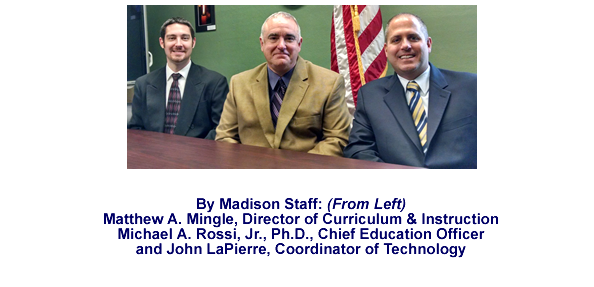- NJASA
- Curriculum Corner October 2014
-
Preparing for PARCC:A Combination of Vision, Curriculum and Technology
In setting out and designing a plan to respond to the PARCC testing initiative, the Madison School District implemented a three-pronged approach. The first of it was based on our District vision and philosophy as it relates to instructional services. We wanted to ensure that everything we did in preparation for the testing was housed under a larger umbrella of what we value as a learning community. Second, we needed to ensure that what we did in the PARCC arena naturally flowed from our program of studies and course content, and was housed within the Common Core State Standards. We looked at our core subject areas as a starting point and mapped out a multi-phase process whereby we revised our curricula to reflect the Common Core and embedded “PARCC-like” questions within our benchmark assessments. It was critical to us to establish a teaching and learning platform by which when the students sit for the PARCC exams, they not only are comfortable and confident, but the environment is something that is very familiar to them. Third, and also quite critical to the success within our pilot and long term achievement, was ensuring that the technology and the logistics to deliver the PARCC exams on a digital platform were seamless. This process ultimately led us to choose, and make a large investment in, the Chromebook and Google applications.
Staying Consistent with Our Vision
In the Madison Public Schools, we place great emphasis on engaging students in a teaching and learning process that is familiar to them and reflects relevancy to their lives. Already ensconced in an initiative to find a device that would allow us to ratchet up our technology-based teaching applications, we sought to leverage on the PARCC assessments by connecting both. Therefore, it was critical to us to ensure that the teaching tool that we believed would be in our long-term best interest for student achievement, would be the same tool that students would utilize as they sat for the PARCC. We believed that this approach would enable us to transfer what we do on a daily basis into standardized assessments. Students would then have natural connections to the PARCC environment because it would be the same teaching and learning atmosphere that they were accustomed to in their classrooms.
A Curricular Foundation
Most fundamental to long-term success, both in the classroom and on the PARCC assessments, was the revision of our curricula to reflect the Common Core and benchmarking that was similar to the challenges students will face in the PARCC assessments. Thus, we established benchmarks throughout our curricula that asked students to explain their answers and write in a persuasive and engaging style in response to a multi-step process. This, likewise, would be enhanced through the use of the Chromebook and computer-assisted software applications. We also recognize that keyboarding and being able to navigate through a tablet, laptop or other computer-based application is critical. Thus, as we move ahead and establish the foundation for our learning, we have done so through a method that makes the delivery of instruction differentiated, digital, and rigorous, as it reflects current standards.
Finding the Right Device
The teaching and learning process, curricular revisions, and consistency with vision cannot be carried out if the technology does not work. Therefore, as we prepared to engage in the pilot for PARCC, we made our decisions based on recommendations from the Madison Technology Task Force. This group is composed of administrators, teachers, Board members, and community leaders who work in technology fields. Our first step was to make sure our building-level infrastructure and backbone was capable of handling hundreds of students taking standardized assessments simultaneously. That required a wireless system to be in place and gatekeeping software to be installed, along with individual Google accounts for every student. During the course of the three years leading up to the PARCC pilot, we tried every device on the market, visited other schools, leveraged the expertise of our Task Force and our own research, and were thoughtful in our decision making process. Ultimately, we chose the Chromebook because we felt it had the ability to transfer in and out of the classroom and into the PARCC testing environment. It has the level of durability we need and it is finically viable for us to move towards a one-to-one initiative long-term. Furthermore, the Chromebook proved to be flawless in its application in the PARCC testing environment.
Summary
Madison is a proud and progressive district and we wanted to respond to PARCC in a manner that was consistent with our vision, was grounded in the teaching and learning process, and provided technology applications so that students could learn on a day-to-day basis and transfer this familiarity into the PARCC testing environment. We wanted to ensure that our students feel confident that they have the skills and knowledge base to be successful and that the technology in front of them would work seamlessly. We are poised and ready to step into the future and meet any challenges from State or Federal mandates and we are confident that our students will continue to succeed and we will sustain the excellence that we have become accustomed to in our schools.




